2007 ISUZU KB P190 Electrical
[x] Cancel search: ElectricalPage 1089 of 6020
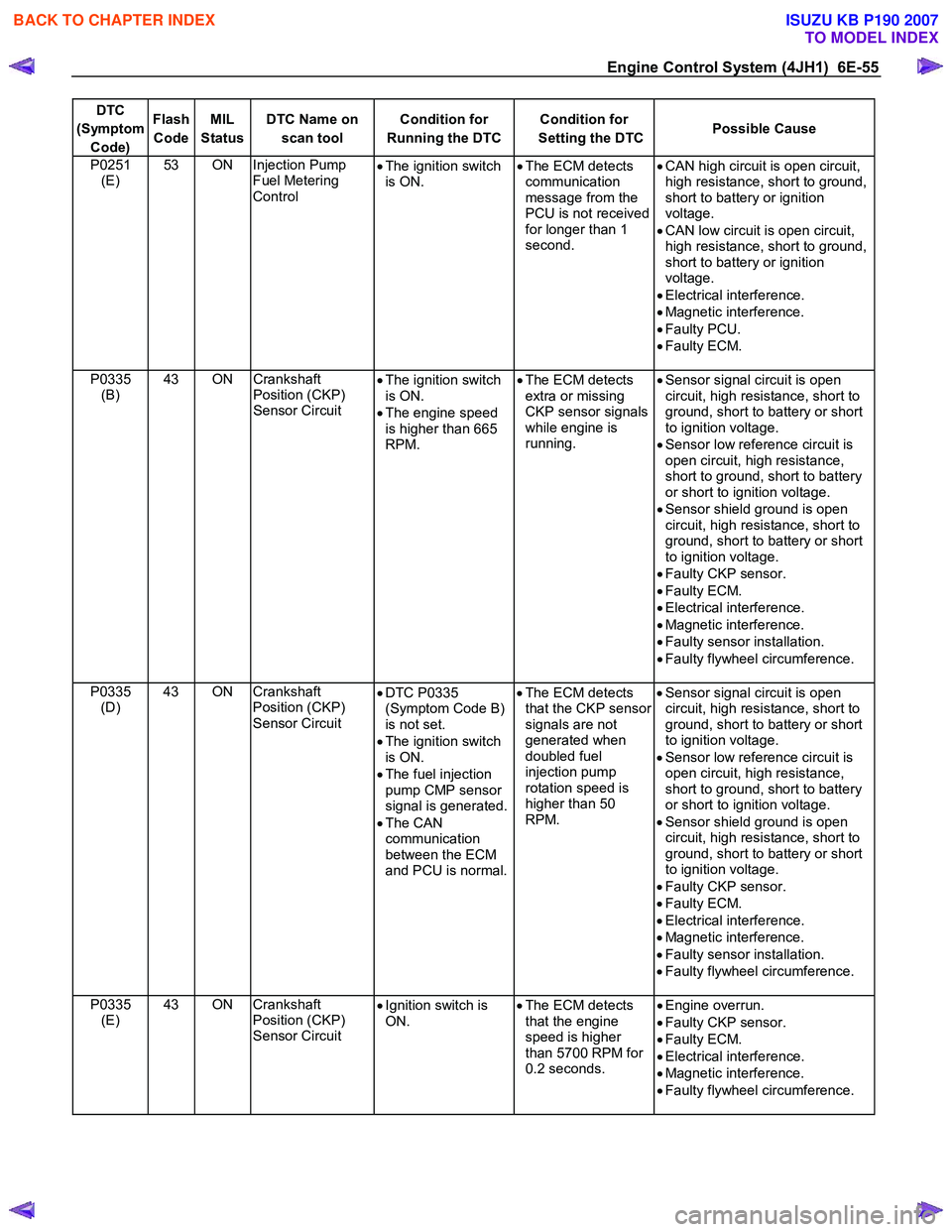
Engine Control System (4JH1) 6E-55
DTC
(Symptom Code) Flash
Code MIL
Status DTC Name on
scan tool Condition for
Running the DTC Condition for
Setting the DTC Possible Cause
P0251
(E) 53 ON Injection Pump
Fuel Metering
Control •
The ignition switch
is ON. •
The ECM detects
communication
message from the
PCU is not received
for longer than 1
second.
•
CAN high circuit is open circuit,
high resistance, short to ground,
short to battery or ignition
voltage.
• CAN low circuit is open circuit,
high resistance, short to ground,
short to battery or ignition
voltage.
• Electrical interference.
• Magnetic interference.
• Faulty PCU.
• Faulty ECM.
P0335 (B) 43 ON
Crankshaft
Position (CKP)
Sensor Circuit •
The ignition switch
is ON.
• The engine speed
is higher than 665
RPM.
•
The ECM detects
extra or missing
CKP sensor signals
while engine is
running. •
Sensor signal circuit is open
circuit, high resistance, short to
ground, short to battery or short
to ignition voltage.
• Sensor low reference circuit is
open circuit, high resistance,
short to ground, short to battery
or short to ignition voltage.
• Sensor shield ground is open
circuit, high resistance, short to
ground, short to battery or short
to ignition voltage.
• Faulty CKP sensor.
• Faulty ECM.
• Electrical interference.
• Magnetic interference.
• Faulty sensor installation.
• Faulty flywheel circumference.
P0335 (D) 43 ON
Crankshaft
Position (CKP)
Sensor Circuit •
DTC P0335
(Symptom Code B)
is not set.
• The ignition switch
is ON.
• The fuel injection
pump CMP sensor
signal is generated.
• The CAN
communication
between the ECM
and PCU is normal.
•
The ECM detects
that the CKP sensor
signals are not
generated when
doubled fuel
injection pump
rotation speed is
higher than 50
RPM.
•
Sensor signal circuit is open
circuit, high resistance, short to
ground, short to battery or short
to ignition voltage.
• Sensor low reference circuit is
open circuit, high resistance,
short to ground, short to battery
or short to ignition voltage.
• Sensor shield ground is open
circuit, high resistance, short to
ground, short to battery or short
to ignition voltage.
• Faulty CKP sensor.
• Faulty ECM.
• Electrical interference.
• Magnetic interference.
• Faulty sensor installation.
• Faulty flywheel circumference.
P0335 (E) 43 ON Crankshaft
Position (CKP)
Sensor Circuit •
Ignition switch is
ON.
•
The ECM detects
that the engine
speed is higher
than 5700 RPM for
0.2 seconds. •
Engine overrun.
• Faulty CKP sensor.
• Faulty ECM.
• Electrical interference.
• Magnetic interference.
• Faulty flywheel circumference.
BACK TO CHAPTER INDEX
TO MODEL INDEX
ISUZU KB P190 2007
Page 1091 of 6020
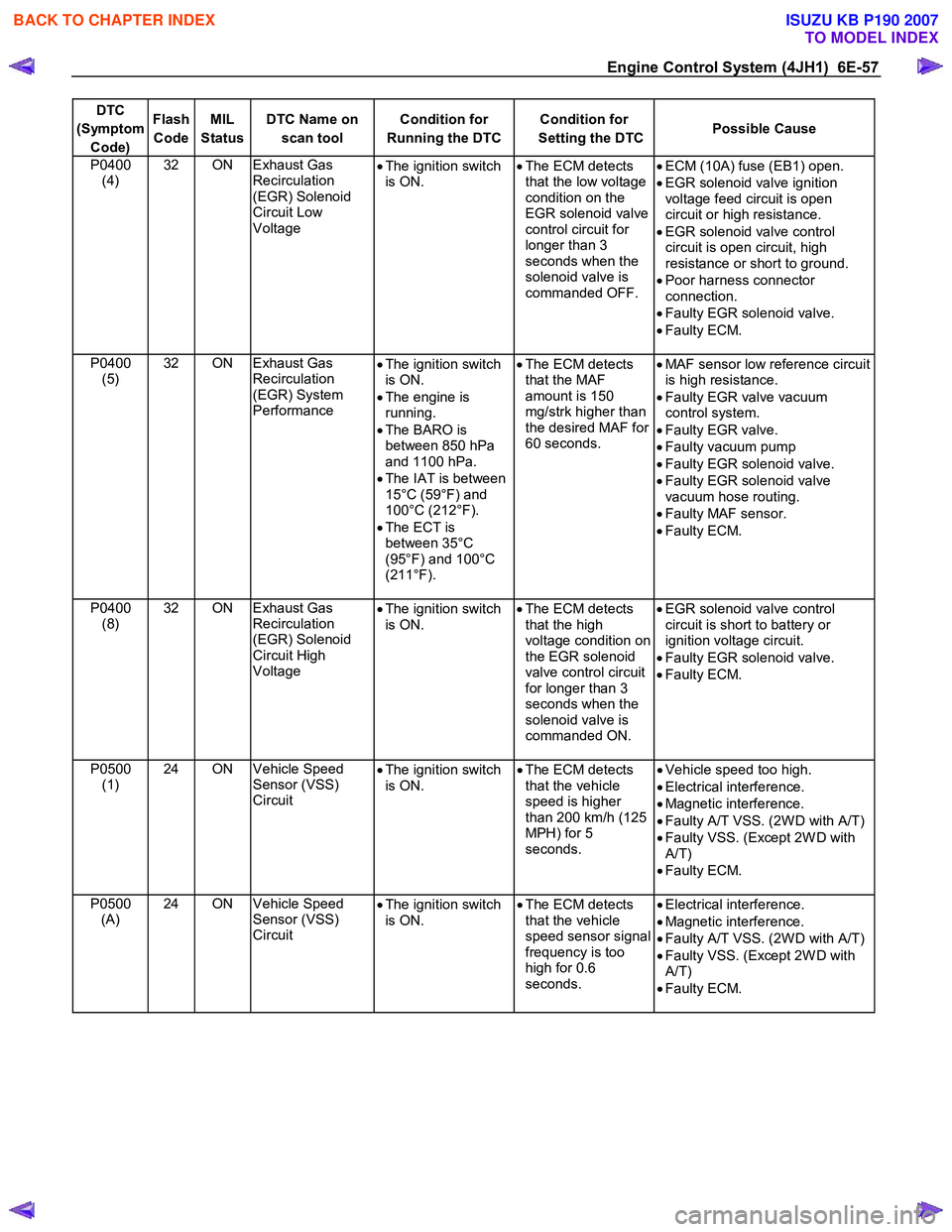
Engine Control System (4JH1) 6E-57
DTC
(Symptom Code) Flash
Code MIL
Status DTC Name on
scan tool Condition for
Running the DTC Condition for
Setting the DTC Possible Cause
P0400
(4) 32 ON Exhaust Gas
Recirculation
(EGR) Solenoid
Circuit Low
Voltage •
The ignition switch
is ON.
•
The ECM detects
that the low voltage
condition on the
EGR solenoid valve
control circuit for
longer than 3
seconds when the
solenoid valve is
commanded OFF.
•
ECM (10A) fuse (EB1) open.
• EGR solenoid valve ignition
voltage feed circuit is open
circuit or high resistance.
• EGR solenoid valve control
circuit is open circuit, high
resistance or short to ground.
• Poor harness connector
connection.
• Faulty EGR solenoid valve.
• Faulty ECM.
P0400 (5) 32 ON Exhaust Gas
Recirculation
(EGR) System
Performance •
The ignition switch
is ON.
• The engine is
running.
• The BARO is
between 850 hPa
and 1100 hPa.
• The IAT is between
15°C (59°F) and
100°C (212°F).
• The ECT is
between 35°C
(95°F) and 100°C
(211°F).
•
The ECM detects
that the MAF
amount is 150
mg/strk higher than
the desired MAF for
60 seconds.
•
MAF sensor low reference circuit
is high resistance.
• Faulty EGR valve vacuum
control system.
• Faulty EGR valve.
• Faulty vacuum pump
• Faulty EGR solenoid valve.
• Faulty EGR solenoid valve
vacuum hose routing.
• Faulty MAF sensor.
• Faulty ECM.
P0400 (8) 32 ON Exhaust Gas
Recirculation
(EGR) Solenoid
Circuit High
Voltage
•
The ignition switch
is ON.
•
The ECM detects
that the high
voltage condition on
the EGR solenoid
valve control circuit
for longer than 3
seconds when the
solenoid valve is
commanded ON.
•
EGR solenoid valve control
circuit is short to battery or
ignition voltage circuit.
• Faulty EGR solenoid valve.
• Faulty ECM.
P0500 (1) 24 ON Vehicle Speed
Sensor (VSS)
Circuit
•
The ignition switch
is ON. •
The ECM detects
that the vehicle
speed is higher
than 200 km/h (125
MPH) for 5
seconds.
•
Vehicle speed too high.
• Electrical interference.
• Magnetic interference.
• Faulty A/T VSS. (2W D with A/T)
• Faulty VSS. (Except 2W D with
A/T)
• Faulty ECM.
P0500 (A) 24 ON Vehicle Speed
Sensor (VSS)
Circuit
•
The ignition switch
is ON. •
The ECM detects
that the vehicle
speed sensor signal
frequency is too
high for 0.6
seconds. •
Electrical interference.
• Magnetic interference.
• Faulty A/T VSS. (2W D with A/T)
• Faulty VSS. (Except 2W D with
A/T)
• Faulty ECM.
BACK TO CHAPTER INDEX
TO MODEL INDEX
ISUZU KB P190 2007
Page 1097 of 6020
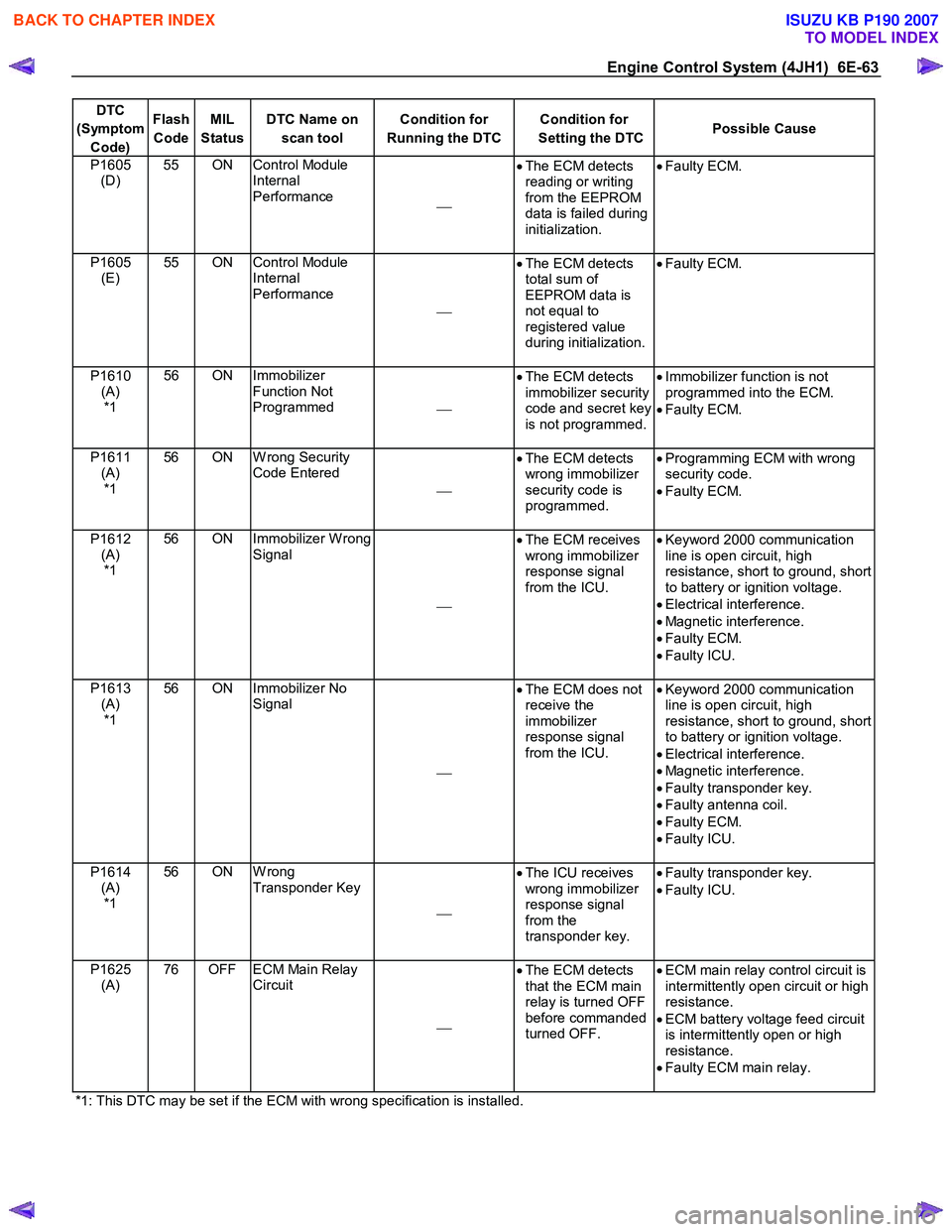
Engine Control System (4JH1) 6E-63
DTC
(Symptom Code) Flash
Code MIL
Status DTC Name on
scan tool Condition for
Running the DTC Condition for
Setting the DTC Possible Cause
P1605
(D) 55 ON Control Module
Internal
Performance •
The ECM detects
reading or writing
from the EEPROM
data is failed during
initialization.
•
Faulty ECM.
P1605
(E) 55 ON Control Module
Internal
Performance
•
The ECM detects
total sum of
EEPROM data is
not equal to
registered value
during initialization.
•
Faulty ECM.
P1610
(A) *1 56 ON Immobilizer
Function Not
Programmed •
The ECM detects
immobilizer security
code and secret key
is not programmed.
•
Immobilizer function is not
programmed into the ECM.
• Faulty ECM.
P1611 (A) *1 56 ON W rong Security
Code Entered
•
The ECM detects
wrong immobilizer
security code is
programmed.
•
Programming ECM with wrong
security code.
• Faulty ECM.
P1612 (A) *1 56 ON Immobilizer W rong
Signal
•
The ECM receives
wrong immobilizer
response signal
from the ICU.
•
Keyword 2000 communication
line is open circuit, high
resistance, short to ground, short
to battery or ignition voltage.
• Electrical interference.
• Magnetic interference.
• Faulty ECM.
• Faulty ICU.
P1613 (A) *1 56 ON Immobilizer No
Signal
•
The ECM does not
receive the
immobilizer
response signal
from the ICU.
•
Keyword 2000 communication
line is open circuit, high
resistance, short to ground, short
to battery or ignition voltage.
• Electrical interference.
• Magnetic interference.
• Faulty transponder key.
• Faulty antenna coil.
• Faulty ECM.
• Faulty ICU.
P1614 (A) *1 56 ON W rong
Transponder Key
•
The ICU receives
wrong immobilizer
response signal
from the
transponder key.
•
Faulty transponder key.
• Faulty ICU.
P1625 (A) 76 OFF ECM Main Relay
Circuit
•
The ECM detects
that the ECM main
relay is turned OFF
before commanded
turned OFF.
•
ECM main relay control circuit is
intermittently open circuit or high
resistance.
• ECM battery voltage feed circuit
is intermittently open or high
resistance.
• Faulty ECM main relay.
*1: This DTC may be set if the ECM with wrong specification is installed.
BACK TO CHAPTER INDEX
TO MODEL INDEX
ISUZU KB P190 2007
Page 1098 of 6020
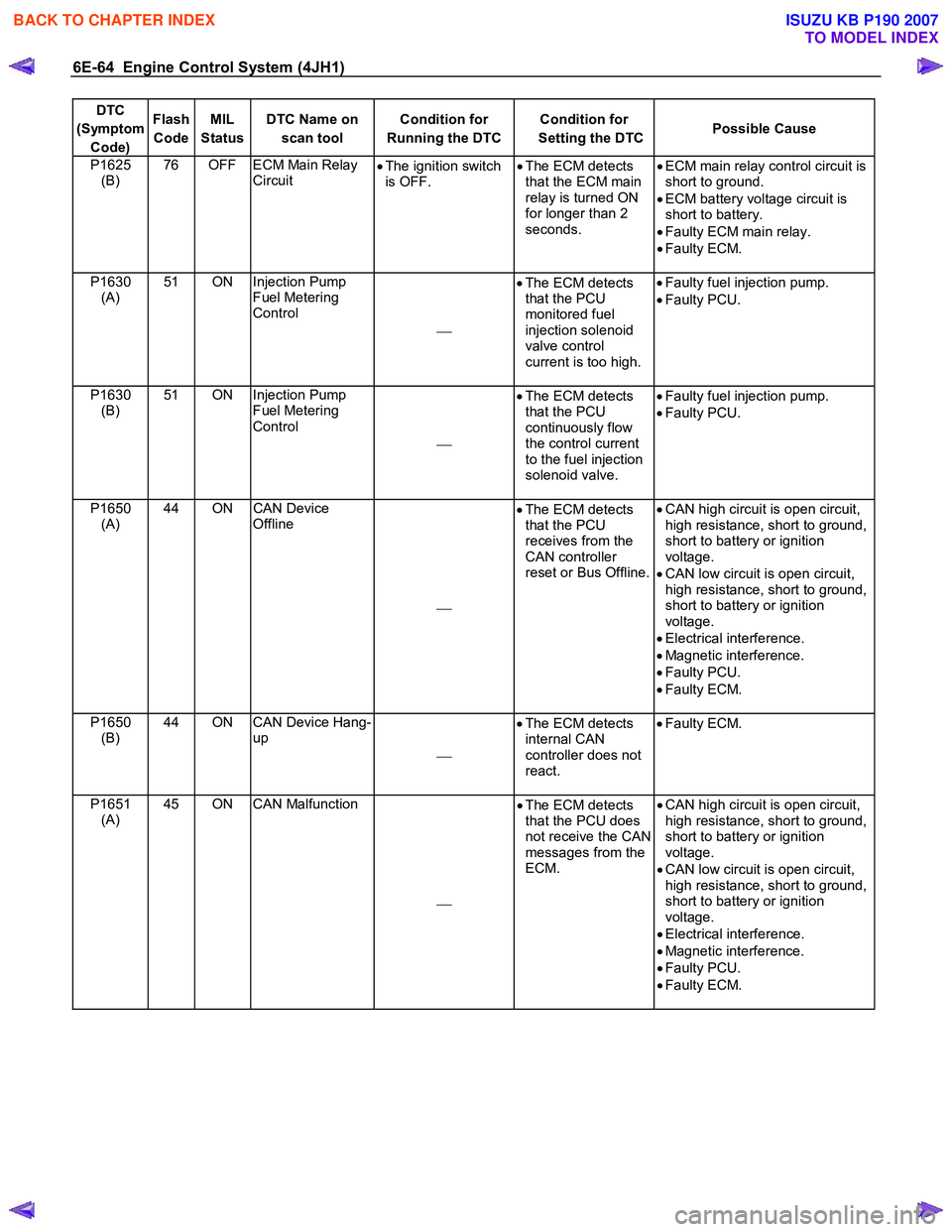
6E-64 Engine Control System (4JH1)
DTC
(Symptom Code) Flash
Code MIL
Status DTC Name on
scan tool Condition for
Running the DTC Condition for
Setting the DTC Possible Cause
P1625
(B) 76 OFF ECM Main Relay
Circuit •
The ignition switch
is OFF. •
The ECM detects
that the ECM main
relay is turned ON
for longer than 2
seconds. •
ECM main relay control circuit is
short to ground.
• ECM battery voltage circuit is
short to battery.
• Faulty ECM main relay.
• Faulty ECM.
P1630 (A) 51 ON Injection Pump
Fuel Metering
Control
•
The ECM detects
that the PCU
monitored fuel
injection solenoid
valve control
current is too high.
•
Faulty fuel injection pump.
• Faulty PCU.
P1630 (B) 51 ON Injection Pump
Fuel Metering
Control
•
The ECM detects
that the PCU
continuously flow
the control current
to the fuel injection
solenoid valve.
•
Faulty fuel injection pump.
• Faulty PCU.
P1650 (A) 44 ON CAN Device
Offline
•
The ECM detects
that the PCU
receives from the
CAN controller
reset or Bus Offline.
•
CAN high circuit is open circuit,
high resistance, short to ground,
short to battery or ignition
voltage.
• CAN low circuit is open circuit,
high resistance, short to ground,
short to battery or ignition
voltage.
• Electrical interference.
• Magnetic interference.
• Faulty PCU.
• Faulty ECM.
P1650 (B) 44 ON CAN Device Hang-
up
•
The ECM detects
internal CAN
controller does not
react.
•
Faulty ECM.
P1651 (A) 45 ON CAN Malfunction
•
The ECM detects
that the PCU does
not receive the CAN
messages from the
ECM.
•
CAN high circuit is open circuit,
high resistance, short to ground,
short to battery or ignition
voltage.
• CAN low circuit is open circuit,
high resistance, short to ground,
short to battery or ignition
voltage.
• Electrical interference.
• Magnetic interference.
• Faulty PCU.
• Faulty ECM.
BACK TO CHAPTER INDEX
TO MODEL INDEX
ISUZU KB P190 2007
Page 1099 of 6020
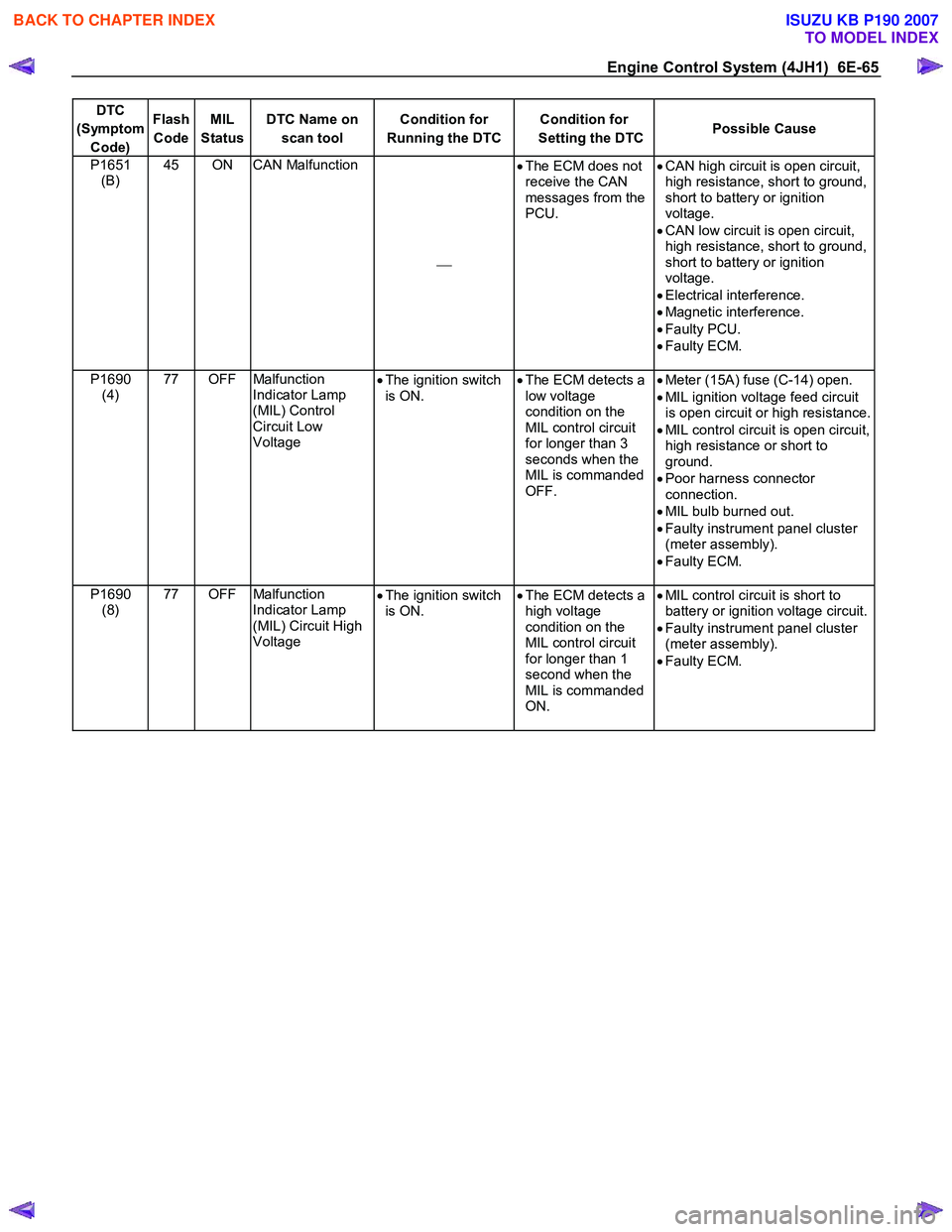
Engine Control System (4JH1) 6E-65
DTC
(Symptom Code) Flash
Code MIL
Status DTC Name on
scan tool Condition for
Running the DTC Condition for
Setting the DTC Possible Cause
P1651
(B) 45 ON CAN Malfunction
•
The ECM does not
receive the CAN
messages from the
PCU.
•
CAN high circuit is open circuit,
high resistance, short to ground,
short to battery or ignition
voltage.
• CAN low circuit is open circuit,
high resistance, short to ground,
short to battery or ignition
voltage.
• Electrical interference.
• Magnetic interference.
• Faulty PCU.
• Faulty ECM.
P1690 (4) 77 OFF Malfunction
Indicator Lamp
(MIL) Control
Circuit Low
Voltage •
The ignition switch
is ON. •
The ECM detects a
low voltage
condition on the
MIL control circuit
for longer than 3
seconds when the
MIL is commanded
OFF.
•
Meter (15A) fuse (C-14) open.
• MIL ignition voltage feed circuit
is open circuit or high resistance.
• MIL control circuit is open circuit,
high resistance or short to
ground.
• Poor harness connector
connection.
• MIL bulb burned out.
• Faulty instrument panel cluster
(meter assembly).
• Faulty ECM.
P1690 (8) 77 OFF Malfunction
Indicator Lamp
(MIL) Circuit High
Voltage •
The ignition switch
is ON. •
The ECM detects a
high voltage
condition on the
MIL control circuit
for longer than 1
second when the
MIL is commanded
ON.
•
MIL control circuit is short to
battery or ignition voltage circuit.
• Faulty instrument panel cluster
(meter assembly).
• Faulty ECM.
BACK TO CHAPTER INDEX
TO MODEL INDEX
ISUZU KB P190 2007
Page 1159 of 6020
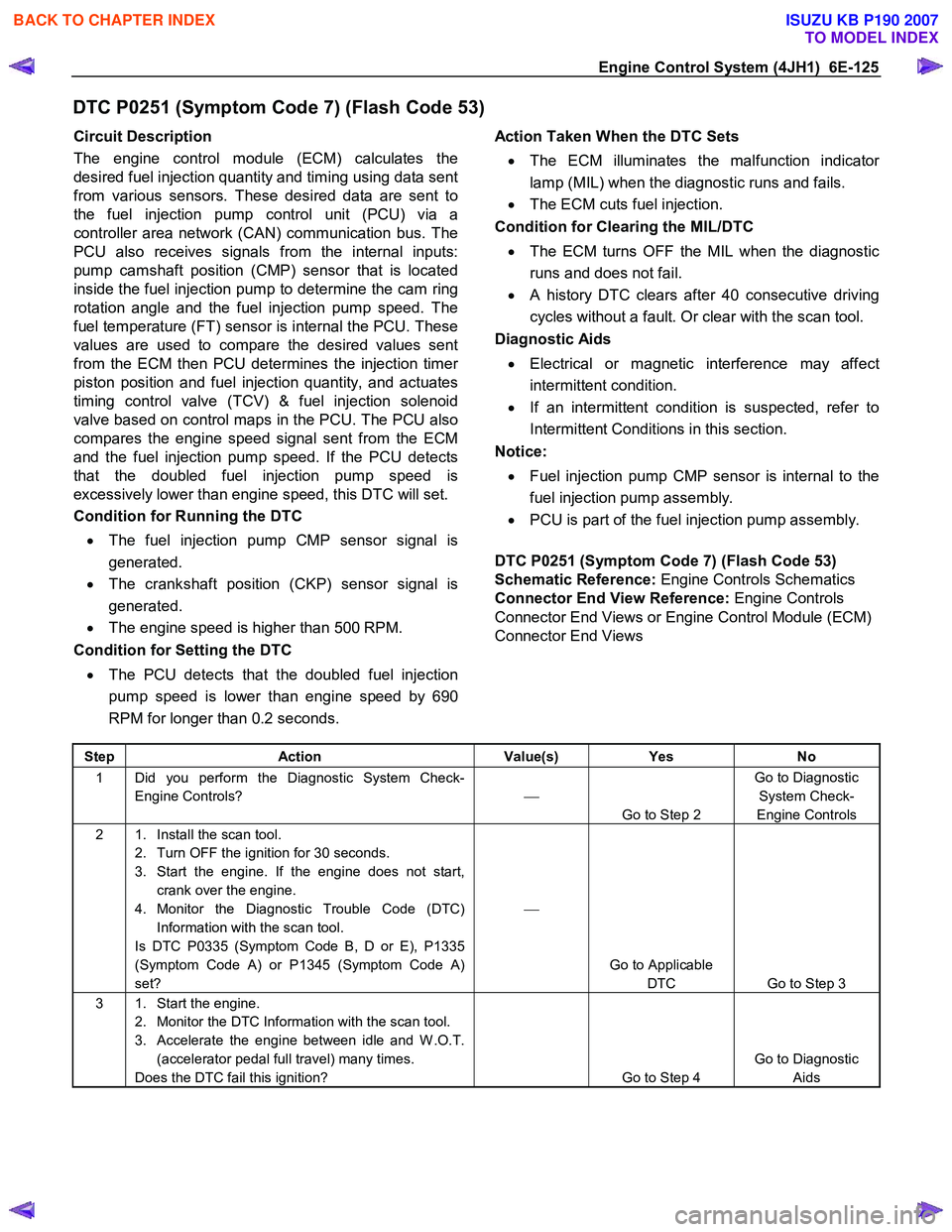
Engine Control System (4JH1) 6E-125
DTC P0251 (Symptom Code 7) (Flash Code 53)
Circuit Description
The engine control module (ECM) calculates the
desired fuel injection quantity and timing using data sent
from various sensors. These desired data are sent to
the fuel injection pump control unit (PCU) via a
controller area network (CAN) communication bus. The
PCU also receives signals from the internal inputs:
pump camshaft position (CMP) sensor that is located
inside the fuel injection pump to determine the cam ring
rotation angle and the fuel injection pump speed. The
fuel temperature (FT) sensor is internal the PCU. These
values are used to compare the desired values sent
from the ECM then PCU determines the injection time
r
piston position and fuel injection quantity, and actuates
timing control valve (TCV) & fuel injection solenoid
valve based on control maps in the PCU. The PCU also
compares the engine speed signal sent from the ECM
and the fuel injection pump speed. If the PCU detects
that the doubled fuel injection pump speed is
excessively lower than engine speed, this DTC will set.
Condition for Running the DTC
• The fuel injection pump CMP sensor signal is
generated.
• The crankshaft position (CKP) sensor signal is
generated.
• The engine speed is higher than 500 RPM.
Condition for Setting the DTC
• The PCU detects that the doubled fuel injection
pump speed is lower than engine speed by 690
RPM for longer than 0.2 seconds.
Action Taken When the DTC Sets
• The ECM illuminates the malfunction indicato
r
lamp (MIL) when the diagnostic runs and fails.
• The ECM cuts fuel injection.
Condition for Clearing the MIL/DTC
• The ECM turns OFF the MIL when the diagnostic
runs and does not fail.
• A history DTC clears after 40 consecutive driving
cycles without a fault. Or clear with the scan tool.
Diagnostic Aids
• Electrical or magnetic interference may affect
intermittent condition.
• If an intermittent condition is suspected, refer to
Intermittent Conditions in this section.
Notice:
• Fuel injection pump CMP sensor is internal to the
fuel injection pump assembly.
• PCU is part of the fuel injection pump assembly.
DTC P0251 (Symptom Code 7) (Flash Code 53)
Schematic Reference: Engine Controls Schematics
Connector End View Reference: Engine Controls
Connector End Views or Engine Control Module (ECM)
Connector End Views
Step Action Value(s) Yes No
1 Did you perform the Diagnostic System Check-
Engine Controls?
Go to Step 2 Go to Diagnostic
System Check-
Engine Controls
2 1. Install the scan tool. 2. Turn OFF the ignition for 30 seconds.
3. Start the engine. If the engine does not start, crank over the engine.
4. Monitor the Diagnostic Trouble Code (DTC) Information with the scan tool.
Is DTC P0335 (Symptom Code B, D or E), P1335
(Symptom Code A) or P1345 (Symptom Code A)
set?
Go to Applicable DTC Go to Step 3
3 1. Start the engine. 2. Monitor the DTC Information with the scan tool.
3. Accelerate the engine between idle and W .O.T. (accelerator pedal full travel) many times.
Does the DTC fail this ignition?
Go to Step 4 Go to Diagnostic
Aids
BACK TO CHAPTER INDEX
TO MODEL INDEX
ISUZU KB P190 2007
Page 1191 of 6020
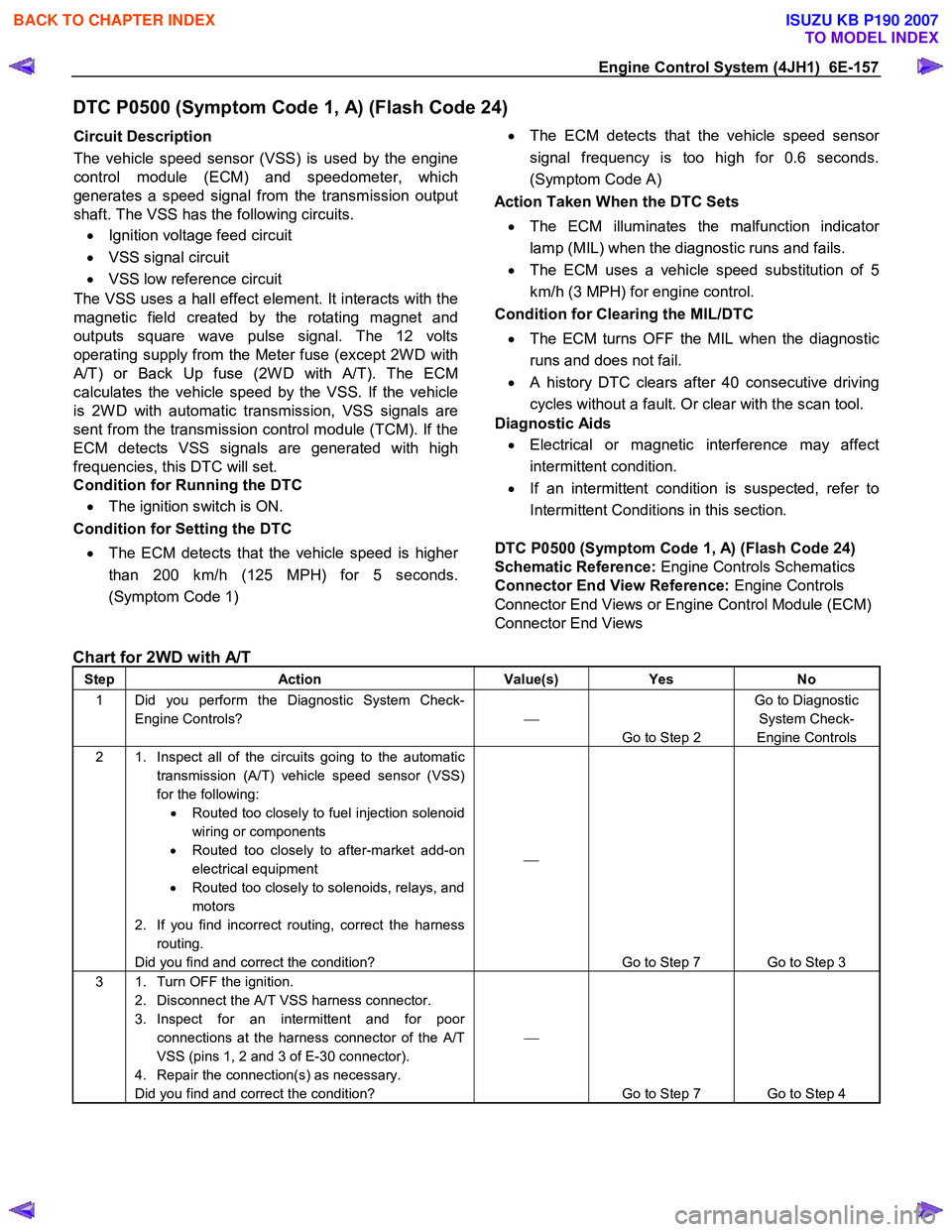
Engine Control System (4JH1) 6E-157
DTC P0500 (Symptom Code 1, A) (Flash Code 24)
Circuit Description
The vehicle speed sensor (VSS) is used by the engine
control module (ECM) and speedometer, which
generates a speed signal from the transmission output
shaft. The VSS has the following circuits.
• Ignition voltage feed circuit
• VSS signal circuit
• VSS low reference circuit
The VSS uses a hall effect element. It interacts with the
magnetic field created by the rotating magnet and
outputs square wave pulse signal. The 12 volts
operating supply from the Meter fuse (except 2W D with
A/T) or Back Up fuse (2W D with A/T). The ECM
calculates the vehicle speed by the VSS. If the vehicle
is 2W D with automatic transmission, VSS signals are
sent from the transmission control module (TCM). If the
ECM detects VSS signals are generated with high
frequencies, this DTC will set.
Condition for Running the DTC
• The ignition switch is ON.
Condition for Setting the DTC
• The ECM detects that the vehicle speed is highe
r
than 200 km/h (125 MPH) for 5 seconds.
(Symptom Code 1)
•
The ECM detects that the vehicle speed senso
r
signal frequency is too high for 0.6 seconds.
(Symptom Code A)
Action Taken When the DTC Sets
• The ECM illuminates the malfunction indicato
r
lamp (MIL) when the diagnostic runs and fails.
• The ECM uses a vehicle speed substitution of 5
km/h (3 MPH) for engine control.
Condition for Clearing the MIL/DTC
• The ECM turns OFF the MIL when the diagnostic
runs and does not fail.
• A history DTC clears after 40 consecutive driving
cycles without a fault. Or clear with the scan tool.
Diagnostic Aids
• Electrical or magnetic interference may affect
intermittent condition.
• If an intermittent condition is suspected, refer to
Intermittent Conditions in this section.
DTC P0500 (Symptom Code 1, A) (Flash Code 24)
Schematic Reference: Engine Controls Schematics
Connector End View Reference: Engine Controls
Connector End Views or Engine Control Module (ECM)
Connector End Views
Chart for 2WD with A/T
Step Action Value(s) Yes No
1 Did you perform the Diagnostic System Check-
Engine Controls?
Go to Step 2 Go to Diagnostic
System Check-
Engine Controls
2 1. Inspect all of the circuits going to the automatic transmission (A/T) vehicle speed sensor (VSS)
for the following: • Routed too closely to fuel injection solenoid
wiring or components
• Routed too closely to after-market add-on
electrical equipment
• Routed too closely to solenoids, relays, and
motors
2. If you find incorrect routing, correct the harness routing.
Did you find and correct the condition?
Go to Step 7 Go to Step 3
3 1. Turn OFF the ignition. 2. Disconnect the A/T VSS harness connector.
3. Inspect for an intermittent and for poor connections at the harness connector of the A/T
VSS (pins 1, 2 and 3 of E-30 connector).
4. Repair the connection(s) as necessary.
Did you find and correct the condition?
Go to Step 7 Go to Step 4
BACK TO CHAPTER INDEX
TO MODEL INDEX
ISUZU KB P190 2007
Page 1192 of 6020
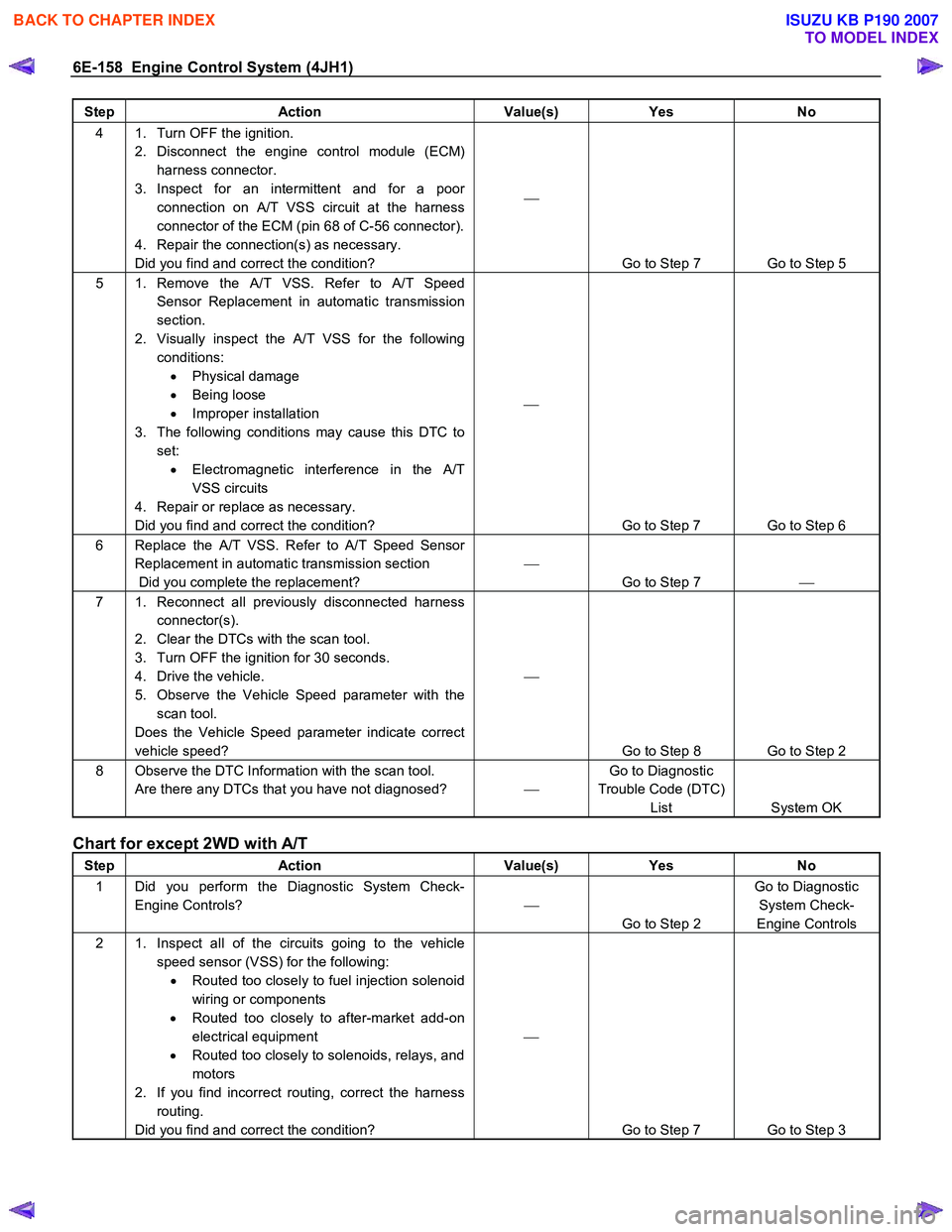
6E-158 Engine Control System (4JH1)
Step Action Value(s) Yes No
4 1. Turn OFF the ignition.
2. Disconnect the engine control module (ECM) harness connector.
3. Inspect for an intermittent and for a poor connection on A/T VSS circuit at the harness
connector of the ECM (pin 68 of C-56 connector).
4. Repair the connection(s) as necessary.
Did you find and correct the condition?
Go to Step 7 Go to Step 5
5 1. Remove the A/T VSS. Refer to A/T Speed Sensor Replacement in automatic transmission
section.
2. Visually inspect the A/T VSS for the following conditions: • Physical damage
• Being loose
• Improper installation
3. The following conditions may cause this DTC to set: • Electromagnetic interference in the A/T
VSS circuits
4. Repair or replace as necessary.
Did you find and correct the condition?
Go to Step 7 Go to Step 6
6 Replace the A/T VSS. Refer to A/T Speed Sensor Replacement in automatic transmission section
Did you complete the replacement?
Go to Step 7
7 1. Reconnect all previously disconnected harness
connector(s).
2. Clear the DTCs with the scan tool.
3. Turn OFF the ignition for 30 seconds.
4. Drive the vehicle.
5. Observe the Vehicle Speed parameter with the scan tool.
Does the Vehicle Speed parameter indicate correct
vehicle speed?
Go to Step 8 Go to Step 2
8 Observe the DTC Information with the scan tool. Are there any DTCs that you have not diagnosed? Go to Diagnostic
Trouble Code (DTC) List System OK
Chart for except 2WD with A/T
Step Action Value(s) Yes No
1 Did you perform the Diagnostic System Check-
Engine Controls?
Go to Step 2 Go to Diagnostic
System Check-
Engine Controls
2 1. Inspect all of the circuits going to the vehicle speed sensor (VSS) for the following: • Routed too closely to fuel injection solenoid
wiring or components
• Routed too closely to after-market add-on
electrical equipment
• Routed too closely to solenoids, relays, and
motors
2. If you find incorrect routing, correct the harness routing.
Did you find and correct the condition?
Go to Step 7 Go to Step 3
BACK TO CHAPTER INDEX
TO MODEL INDEX
ISUZU KB P190 2007